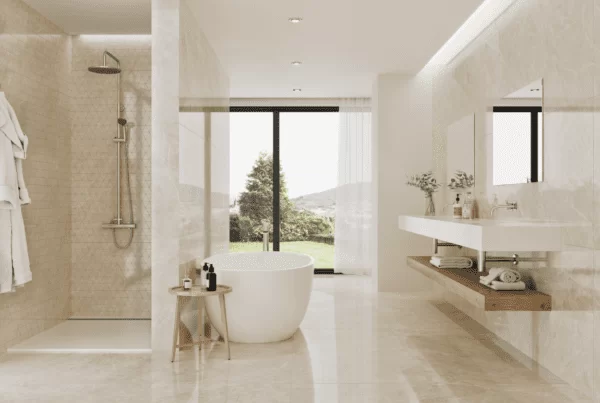How density differs between the two, and why it matters
Porcelain tiles are made in a very similar way to ceramic tiles, and this is because porcelain has been derived from ceramics. Porcelain came about a few centuries ago, has only been in use in homes and offices for walls and floors and as decorative cladding for around 200 years. However, ceramics have been in use for thousands of years now, and they are believed to have been first made and discovered by the Romans somewhat 4000 BC…a VERY long time ago! But as technology progressed, and as chemical knowledge amongst scientists and experts developed, manufacturers were able to test out new methods and to come up with new processes during the production of tiles, and so this is how porcelain came about…and obviously porcelain is much better and much more preferable amongst most of the customers, but still not all, as ceramics are still more practical for certain functions. Porcelain and ceramics are still made in very similar ways, but there a few differences between them, and that is why each one of the two has its own set of characteristics and distinctive roles.
Raw Materials
Clay is the main raw material used in both porcelain and ceramics, and this clay consists mainly of hydrous Aluminium Silicate and Kaolin molecules (compound that is similar to Aluminium Silicate but with a hydroxide molecule within its chain instead of water that makes the Aluminium Silicate a hydrous molecule once mixed in with it and bound to it). Clay is also easily found in nature, as it is quite abundant, and it is not a rare valuable sort of material. Clay is also relatively easily extracted, shaped, heated and transported, as it is quite light and extremely flexible when wet, unlike other brittle minerals and hard surfaces. In ceramics though, the clay used is not modified, it is purely extracted and taken to the manufacturing site to be used in making the tiles.
The clay used is also classified as secondary clay, which is a kind of clay found in places that have large rivers or small channels, as these waters are powerful enough to drag the silt for a relatively long distance, mixing it with a wide variety of minerals and other materials, before depositing it to allow the formation of clay, and so this secondary type of clay would be coloured rather than white, and would contain a lot of different materials, which clearly explains why it is also called sedimentary clay. This is an extremely important difference which we will touch upon again further down this article.
In addition to clay, Feldspar is also used within the porcelain mixture, and it is a substance formed of flint with Aluminium Silicate. Flint is a type of hard Quartz, and so this allows feldspar to function as a flux within the porcelain mixture, meaning that it reduces the temperature at which liquid gas is formed. Additional Silica may also be added into the porcelain mixture, to be used a filler within the compound, in order to conduct heat effectively across the mix. These materials are essential as the clay used in porcelain is refined clay, meaning that unlike the one used in ceramics, it is primary clay, and so does not contain a blend of other minerals within its structure. Furthermore, it is refined before reaching the production lines, as it is filtered and structured nicely for ease of use and the bettering of tiles production beforehand. However, unlike the minerals found in secondary clay, the additional materials added to the porcelain mixture keep the stone pure, clean and smooth, unlike ceramics.
Addition of Sand
The cherry on top of all the various materials used within the porcelain mixture, finely ground sand is also stirred within, and this makes the porcelain mixture much denser than the natural clay with its minerals used in ceramics. In turn, this then allows for porcelain to be compressed at a much higher pressure, meaning that following the time spent in the kiln, porcelain becomes much more durable and hard-wearing. As a result of that strength that porcelain gains from the high-pressured compression, it can be made into very thin tiles that can come in 6mm thickness, and so they will be much lighter than the relatively thick ceramic tiles, and so they are easier to handle and much cheaper to install, and yet they are still denser and so much more long-lasting.
Moreover, porcelain also becomes less porous during this process, as it can be fired at a much higher temperature than ceramics, which ceramic tiles will not be able to handle, and they will crack within the kiln. Ceramics tend to be fired at around 1,100 degrees Celsius, which is much lower compared to the temperatures of around 1,400 degrees Celsius that porcelain tiles are fired at. These very high temperatures firing a very dense material prevents any small pores or air spaces forming within the stone, and so this causes porcelain to be much more stain-resistant, as liquids are not able to pass through the stone easily at all to leave a mark underneath the surface.
Functionality of ceramics vs porcelain
Consequently, as the porcelain tiles are made from a much purer and functional mixture than ceramics, and due to its higher density, porcelain can be used for many different types of applications. These days, we see large porcelain slabs that are very thin to be used for walls, but at the same time, we also see very thick porcelain tiles that can be used for the outdoors, and can withstand tonnes of heavy weight on top, even during extreme weather conditions such as when it is raining cats and dogs or when the sun is melting everything in its way. On the contrary, ceramics are only used for the indoors, as they are not at all as practical or as durable for the outdoors as porcelain is made to be.



